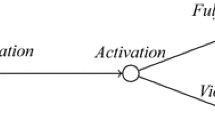Abstract
This paper discusses the development of O-cubed (operational organization oriented) modeling and a simulator for computational organization design. O-cubed modeling is used to describe an organization model in terms of models of coordination structures, tasks, and agents. The model of a coordination structure can represent not only task decomposition and allocation, but also choices between hierarchical management and autonomous management. The model of a task can represent the workflow within an organization. Using the O-cubed simulator, we can easily describe the models for coordination structure, tasks and agents, so that agents can make decisions concerning task processing and choose coordination structures effectively. In order to show applicability of the modeling and simulator, we describe an O-Cubed model of cooperation in a kitchen of a restaurant. The cooperation is good example to explain organization design, because it contains balanced elements of coordination structures, tasks, and agents. The example show that the organization models described by O-cubed modeling and the simulator are promising models for designing organizations.
Similar content being viewed by others
References
Abbas, S. and G. O'Hare (1997), “Incorporating Organizational Design Principles and Experiences into the Design and Implementation of Multi Agent Systems, ” in S. Krin and G. O'Hare (Eds.) Cooperative Knowledge Processing: The Key Technology for Intelligent Organizations. Springer-Verlag, London, pp. 173–195.
Cammarata, S., D. McAuthur and R. Steeb (1983), “Strategies of Cooperation in Distributed Problem Solving, ” in Proceedings of the Eight International Joint Conference on Artificial Intelligence. Karlsruhe, West Germany, pp. 767–770.
Carley, K.M., J. Kjaer-Hansen, A. Newell and A. Prietula (1992), “Plural-SOAR: A Prolegomenon to Artificial Agents and Organizational Behavior, ” in M. Masuch and G. Massimo (Eds.) Distributed Intelligence: Application in Human Organizations. North-Holland, Amsterdam, pp. 87–118.
Carley, K.M. and M.J. Prietula (1994), “ACTS Theory: Extending the Model of Bounded Rationality, ” in K.M. Carley and M.J. Prietula (Eds.) Computational Organization Theory. L. Erlbaum, Hillsdale, NJ, pp. 55–87.
Crowston, K. (1994), “Evolving Novel Organizational Forms, ” in K.M. Carley and M.J. Prietula (Eds.) Computational Organization Theory. L. Erlbaum, Hillsdale, NJ, pp. 19–38.
Davenport, T.H. (1993), Process Innovation, Reengineering Work Through Information Technology. Harvard Business School Press, Boston, MA.
Davis, R. and R.G. Smith (1983), “Negotiation as a Metaphor for Distributed Problem Solving, ” Artificial Intelligence, 20, 63–109.
Galbraith, J.R. (1977), Organization Design. Addison-Wesley, Reading, MA.
Ishida, K. (1996), “A Modeling Language for Simulating Collective Behavior Among Intelligent Performers, ” IPSJ SIG Notes (in Japanese), pp. 1–8.
Jacobson, I., M. Ericsson and A. Jacobson (1994), The Object Advantage: Business Process Reengineering with Object Technology. ACM Press, New York.
Kang, M., L.B. Waisel and W.A. Wallance (1998), “Team Soar: A Model for Team Decision Making, ” in M.J. Prietura, K.M. Carley and L. Gasser (Eds.) Simulating Organizations: Computational Models of Institutions and Groups. MIT Press, Cambridge, MA, pp. 23–46.
Laird, J.E., A. Newell and P.S. Rosenbloom (1987), “SOAR: An Architecture for General Intelligence, ” Artificial Intelligence, 33, 1–64.
Lin, Z. (1994), “The Choice Between Accuracy and Errors: A Contingency Analysis of External Conditions and Organizational Decision Making Performance, ” in K.M. Carley and M.J. Prietula (Eds.) Computational Organization Theory. L. Erlbaum, Hillsdale, NJ, pp. 67–88.
Malone, T.W. (1987), “Modeling Coordination in Organizations and Markets, ” Management Science, 33(10), 1317–1332.
Shoham, Y. (1990), “Agent Oriented Programming, ” Technical Report STAN-CS-90-1334, Stanford University.
Shoham, Y. (1993), “Agent Oriented Programming: Methodology and Application, ” Artificial Intelligence, 60, 51–92.
Smith, A. (1937), The Wealth of Nations. Random House, New York.
Author information
Authors and Affiliations
Rights and permissions
About this article
Cite this article
Ishida, K., Ohta, T. O-Cubed Modeling and Simulator for Computational Organization Design. Computational & Mathematical Organization Theory 7, 155–176 (2001). https://doi.org/10.1023/A:1011357005795
Issue Date:
DOI: https://doi.org/10.1023/A:1011357005795




